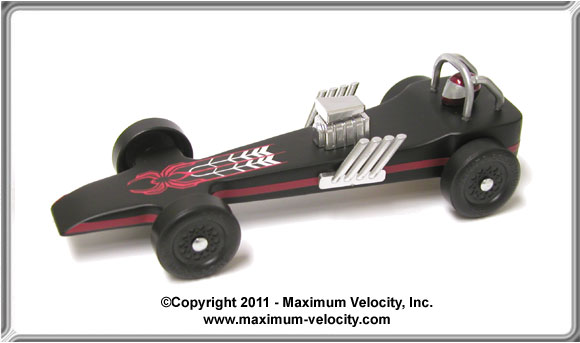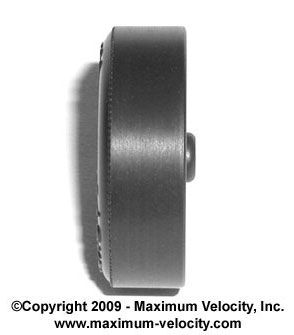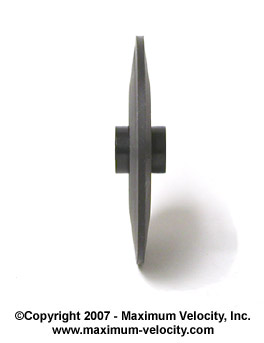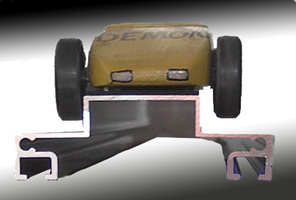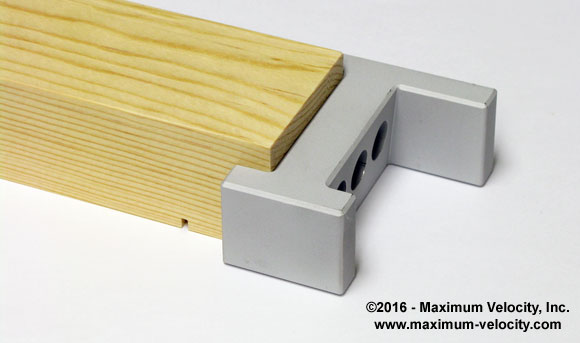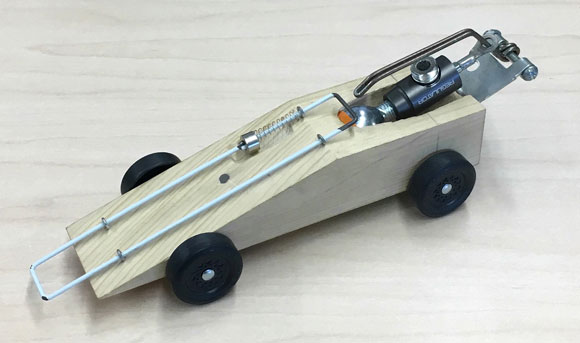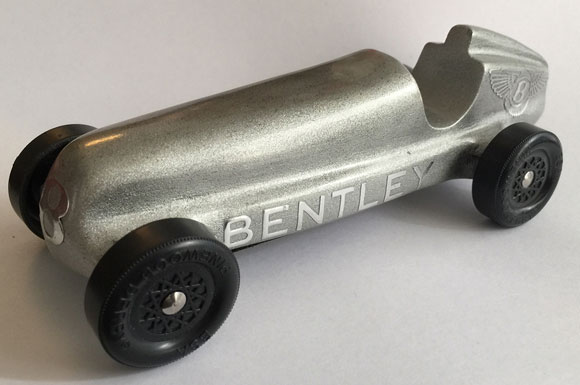PINEWOOD DERBY TIMES
Volume 16, Issue 8
January 11, 2017
In this Edition
– Editor’s Notes
– Feature Article – Buying a New Track? Let’s Consider Some Factors
– Humor
– Product Showcase – T-Tool Weight Drilling Jig – $2.00 Off (Over 10%)
– Pinewood Derby Memory – Grandkids Reign
– Pinewood Derby Car Showcase
– Q&A
Editor’s Notes
MV Basic & Wedge Car Kits

– Quality Block – Unlike the blocks provided by some organizations, our blocks are soft, northwestern pine blocks, cut precisely to 7 inches long, 1-3/4 inches wide, and 1-1/4 inches tall. These dimensions, as well as the axle slots accurately duplicate the dimensions of standard pinewood derby blocks from BSA and PineCar.
– Simple Axle Preparation – Don’t worry about filing off flaws, or losing hub caps. Our Speed Axles have no burrs or crimp marks, and install without hub caps. With or without polishing, they are ready to go. We supply five, so you have a spare.
– Quality Wheels – Forget cheap, out of round wheels. Our MV wheels are top-quality wheels. You will not be disappointed with the quality of these wheels.
So, if your organization does not mandate a particular kit type,
consider our MV Basic Car Kits or MV Wedge Car Kits.
Call for Photos
Help, we are virtually out of photos for the pinewood derby car showcase. Please send us a photo of your car along with a description of any special features to:
in**@**************ty.com
Please include your full name. If selected, we will include the photo and description in this newsletter.
Photos must be sent by e-mail in JPG format (minimum size of 640×480, maximum size of 1280 x 960). Please shoot photos from the front left of the car, similar to the orientation of car shown at:
Make sure the photo is not blurry. If your photos are blurry, try holding the camera four or five feet away from the car, and then use the camera’s zoom to fill the frame with the car. Also, use a solid (preferably white) background for the photo.
Send only one photo per car, unless an additional photo is needed to adequately show a feature. Don’t forget to include your name, the name of the car (if it has one), and a brief write up on any design features, inspiration for the design, and how the car performed at the race. Thanks.
Inventory Clearance Sale
We are clearing inventory on several items including:
– Discount slotted blocks
– Formula One car kit
– Wheel Flares and Paint Stencils
– Raingutter Regatta Decals
We don’t have many left, so don’t delay. You can find these items Here.
Can We Help?
If we can help you in any way with your pinewood derby project, or if you have any feedback regarding this newsletter, please Contact Us.
Feature Article
Buying a New Track? Let’s Consider Some Factors
By Randy Davis
Back in 2003, I ran article written by Steve Monk(1) about purchasing a pinewood derby track. That article provided a lot of good information at a time when aluminum tracks were relatively new. Now, thirteen years later, aluminum tracks are firmly established, and wood tracks are fading. So, I thought it was time to revisit the subject.
There are many factors involved in the purchase decision of a pinewood derby track. Obvious factors include:
– Budget,
– Number of lanes and expandability,
– Length, and
– Available electronics (timer, solenoid start gate, etc.).
But some other, maybe less obvious factors include:
– Compatibility of the car kit being used with the track,
– Life expectancy of the track, storage, and maintenance.
– Stability,
– Ease of setup,
– Functionality of the braking section.
Let’s take a look at each of these factors.
Budget
As a track purchaser, the organization budget is usually the most important factor. Certainly money is an important factor, but consider that the purchase of a track is not like buying a soda whereby you consume it then toss the can. Instead, it is more like purchasing an automobile that will be used for ten years, twenty years, or maybe longer.(2) Since you, or future race leaders will be using the track for many years to come, factors such as life expectancy, compatibility with other equipment, ease of setup, and ease of maintenance are important factors that should not be ignored. So, don’t be short-sighted; make sure to take the long-term picture into consideration.
Number of Lanes
Many people will tell you that the bigger the group, the more lanes you need. Their reasoning is that if more cars can race simultaneously, then the event will go more quickly. But this logic, as we shall see, is in error. In reality, a track of over four lanes is not really needed unless you are going for a “wow” factor. Let’s look at the numbers.
Today, most races are staged with computer software which assigns each car to race once in each lane. So, let’s say that you have 100 cars and each car is going to race one heat in each lane. For a four lane track you will need 100 heats. For a six lane track, you will need 100 heats. Now consider how long it takes to stage four cars, run the heat, and retrieve the four cars, versus the amount of time needed to stage six cars, run the heat, and retrieve the cars. The heat time for the six lane track will be slightly longer in order to deal with the extra cars. So, the six lane track will result in a longer event.
You might say, “On the six lane track, just have the cars run in four of the lanes.” Of course you could do that, and if the track was perfectly consistent from lane to lane you would have a fair event. But in reality no track is perfectly consistent from lane to lane. There is always some variance between lanes, and this variance will change from one year to another. So if, for example, lane five was a slower lane, any car that did not run in lane five would have an advantage.
Well enough on the numbers, let’s go back to the budget for a moment; a six lane track will cost essentially 50 percent more than a four lane track of the same length (even the timer will cost more). So a 50 percent increase of budget will provide some “wow” factor, but will do nothing to improve the length or fairness of the event.
Track Length
How long of a track should you get? Well, certainly the track needs to fit in the room, and again longer tracks do have a “wow” factor. But, in my opinion, the only reason for having a track longer than 32 to 35 feet is to accommodate a larger audience – the longer the track, the more track-side seating space is available. But there are downsides to longer tracks:
– Longer tracks are more expensive and take longer to setup.
– Longer tracks increase the event time. Although each race down a longer track is just a split second longer, the time to walk the cars back to the staging area is a larger factor, and cumulatively will increase the length of the event.
– More cars will not make it to the finish line, which is a real bummer for race participants.
I have heard some folks say that longer tracks are better because they reduce the number of ties (the longer track tends to spread out the cars). This is true, but with modern race management, the timers and
software automatically handle ties, eliminating the need to have run-offs. So ties are not really an issue anymore.
In conclusion, if you have a larger group, and the budget to afford a longer track, go ahead and get an extra track section or maybe 2. But just recognize the downside to doing so. Also consider that many of the tracks allow you to add a section at a later time. So you can start with a 32 to 35-foot track and then add a section when your group expands in membership.
Available Electronics
When you purchase a track, you will want to get a timer with race software, and possibly a solenoid starting gate. Most tracks are compatible with all of the major timers, and solenoid gates are available for most tracks. But before purchasing a track, select a timer as well and make sure it is compatible with the intended track. Similarly, if you want a solenoid gate, make sure one is available that will work with the intended track.
Car Kit Compatibility
In general, there are two types of tracks: center lane guide, and side guide. On center lane guide tracks, cars straddle a lane guide rail, while on side guide tracks cars run between two guide rails.
Figure 1 – Lane Guide Configurations
On the surface, this does not seem to be a big difference. But let’s consider pinewood derby kit wheels. Wheels are of two type: offset and symmetrical. Offset wheels are those wheels that have an outer sidewall and an inner edge. In order to work properly, the wheels are mounted such that the sidewall faces away from the car body while the inner edge is mounted towards the car body. Examples of offset wheels are: BSA, MV, Awana, and PineCar.
Figure 2 – Offset Wheel (BSA)
Symmetrical wheels are molded such that the wheel can be mounted either way. On these wheels there is no inside or outside. Examples of symmetrical wheels are: Royal Racer, RA Racer, and Royal Ranger/S&W.
Figure 3 – Symmetrical Wheel (RA Racer – Speed Version)
Now here’s the rub: offset wheels are designed to only contact a guide rail on the inner edge. Raised lettering, tread markings on the outside of the wheel make contact with a guide rail undesirable. Thus, offset wheels are designed for center lane guide tracks. On the other hand, symmetrical wheels can be used on either center lane guide or side guide tracks.
In summary, if your group uses offset wheels, you will want to get a center lane guide track. If your group uses symmetrical wheels, you can use either track type.
Life Expectancy, Storage, and Maintenance
If used with care and stored properly, tracks will last for many years. Generally, tracks should be stored flat on the ground in a climate-controlled area, and should be enclosed in a case. If tracks are stored upright, the lanes may develop a warp. Similarly, if a track is exposed to excessive heat, cold or humidity, warping can occur. This is especially true of wood tracks, but plastic tracks are also susceptible. Light exposure can also affect plastic and wood tracks.
Aluminum tracks are less susceptible to warping, but aluminum does oxidize. Over time, a white, slightly sticky powder will appear on aluminum tracks which must be scoured off. A plastic scrub pad and Simple Green will clean it off, but it does take some “elbow grease”.
Oxidation can be eliminated by anodizing. This is a process where the surface of the track is hardened via an electrochemical process. The resulting surface has a “satin” look and feel, and will not oxidize.
Figure 4 – Non-anodized (left) versus Anodized (right)
(Source: microwizard.com)
STABILITY
Track stability refers to the rigidity of the elevated starting section, as well as the track section connections. The support structure of the elevated section should be rigid so that the track does not sway when the start gate is activated and when the cars race through the curve. Generally, wood and aluminum tracks have more stability, while plastic tracks, being lighter in weight, are more susceptible to swaying.
The track sections need to be rigidly attached to each other. During the race people will walk back and forth along the track, and when an errant foot kicks the track (it will happen), the track sections should stay firmly together, with no misalignment of the track sections.
EASE OF SETUP
The twenty year-old track our group uses is not easy to setup. It requires each track section to be individually aligned, and an expert (me) is needed to put it together. Modern tracks should not have these problems.
A track should be easy to assemble and have positive alignment. The track assembly procedure should be straightforward and obvious. Since track setup will likely be performed by different people each year, a setup expert should not be needed. A simple assembly manual is fine, but it should not require detailed study.
Positive alignment means that track sections should have connection guides built in so that the assembly team does not have to worry about alignment.
Functionality of the Braking Section
The quality of the braking section is just as important as the rest of the track. A track that provides a great race, but results in breakage when the cars are stopped is not acceptable. The fastest cars are the cars that are the most susceptible to damage as they have the highest speeds. So the braking section needs to be able to safely stop the fastest cars with any damage.
The most effect stop systems have an elevated center lane whereby the cars skid to a stop on their “bellies”. Preferably, the rolling section of the track drops away so that the car transitions smoothly into the braking section. Some braking sections ramp up, which can cause derailment. Other braking section have foam stops which can cause damage on impact or on the rebound.
Figure 5 – Stop Section
(Source: besttrack.com)
Commercially Available Tracks
Company Composition Center/Side Guide
BestTrack Aluminum Center
MicroWizard Aluminum Center
Derby Magic Plastic Center
Super Timer Plastic Side
S&W Crafts Wood Side
CONCLUSION
Purchasing a track is a major decision, with many factors to consider. I hope that you find this article helpful in working through the various factors so that you can find the right track for your organization.
(1) Steve Monk is the owner of Best Track.
(2) The track we use is over twenty years old.
Humor
A commercial property owner has three shops in a row, all for rent. The first prospective lessee shows up, and says he wants to rent the shop on the left.
The owner says, “Fine, what kind of shop do you have?” The guy says, “A men’s wear shop.” The owner tells him he gets free signage and asks what he wants on the sign. “Men’s Wear,” says the man.
A second guy comes along and wants to rent the right hand shop. When asked he says he wants “Men’s Wear” on his sign. The owner tells him that the left hand shop will be the same. “No problem,” says the man.
Finally a third man comes along to rent the middle shop. The owner is most concerned because this guy also has a men’s wear shop. Rather wearily the owner asks him what he wants on his sign. The guy replies: “Entrance.”
Product Showcase
T-Tool Weight Drilling Jig – $2.00 Off (Over 10%)
For top speed, weight needs to be accurately placed. Now anyone can create accurate weight holes for tungsten cylinders, lead wire, or tundra rod with only a hand drill.
The T-Tool is a precision-machined, aluminum jig that will improve the speed of your pinewood derby car through accurate weight placement. The T-Tool:
– Ensures accurate weight placement by allowing you to drill precise weight holes into the side, back, or bottom of a pinewood derby block.
– Can drill straight holes, or holes at a slightly downward angle for wedge-shaped cars.
– The guide holes in the T-Tool are sized for a 25/64 inch drill bit (perfect for tungsten and lead). The drill bit is not included; it is sold separately Here (part 5001).
Through January 24, 2017, you can get a T-Tool Weight Drilling Jig for $2.00 off. To take advantage of this limited time offer, add part 5144 to your shopping cart and use coupon code JAN11NL during checkout.
Pinewood Derby Car Showcase
CO2 Outlaw – Jordan Runsvold
Just wanted to share my outlaw derby car from this year. With CO2 power, its best run was 0.9305 seconds on our 35 foot BestTrack. The valve was a modified bike tire inflator.
In the video you will see a zip-tie flying off. It was securing the firing mechanism until the car was on the track. Typically I would remove it before starting the race, but that one wedged its way in there and I didn’t want to risk a premature firing when removing it.
That’s one of the things I hope to eliminate in next year’s car – the cylinder and valve assembly will have a “safety” to allow easier handling before the race.
Bentley B – Brian Bradford
From Bentley: That is the “Bentley B” One day I was playing Mario Kart and I thought the design of the Mercedes-Benz W25 Silver Arrow would be an awesome pinewood body design. Also, I thought it would be cool to put Bentley on there – which is my name – instead of Mercedes signs.
Note from Dad: In our building process, we coincidentally discovered that most of the long, low, un-fendered 1930’s Grand Prix cars match up very well with Pinewood Derby proportions and stock wheelbase. If you’re looking to make your car proportionally look like an actual car, these may be a good place to start.
Share Your Car With Our Readers
Do you have a car you would like to “show off” to our readers? If so, send us a photo of your car along with a description of any special features to:
in**@**************ty.com
Please include your full name. If selected, we will include the photo and description in this newsletter.
Photos must be sent by e-mail in JPG format (minimum size of 640×480, maximum size of 1280 x 960). Please shoot photos from the front left of the car, similar to the orientation of this car:
For better focus, keep the camera four or five feet away from the car, and then use the camera’s zoom to fill the frame with the car. Also, use a solid (preferably white) background for the photo.
Send only one photo per car, unless an additional photo is needed to adequately show a feature. Also, only one car per subscriber per year please. Thanks.
Pinewood Derby Memory
Grandkids Reign
I have three granddaughters: one is in Kindergarten, the second is in pre-school, and the third is only three. Recently, all three got to compete in an Awana Grand Prix.
The day of the race, my son came over with the three girls’ cars to put the wheels on. He anticipated only about a 20-minute job, so he brought the girls and a video for them to watch. His wife wasn’t feeling well and stayed home for a nap.
Three hours later, she woke up and called wondering where they were. We were still working on the cars, but time was running out so we weren’t able to polish the wheels or the insides of the hubs. We aligned the cars and took them to the sign-in.
That night, the oldest girl took first in speed, and the middle one got third. The youngest was headed for either second or third when, on the last race, her car jumped the track. I have no idea why – it was running well.
We came that close to having a family lock on speed at this race!
Les Aldrich
Bonner Springs, Kansas
Perspective
A week ago my son and I had just finished weighing in his car for his Pack’s race. We were in the car on the way home. Patrick, who is eight, thanked me for helping him with his car and then said, “I am sure glad you are my dad.” Pretty much makes nothing else matter.
PJ Harrigan
Mesa, Arizona
Do you Remember?
If you have a pinewood derby story that is funny, unusual, sad, heart-warming, etc., please send it to me in an e-mail. Don’t worry about literary polish. We will edit as needed before publishing.
If your story is used, you will receive a $10 coupon in May of 2017.
Q&A
Q: What changes need to be made to a BSA legal car for faster times on different length tracks? We run on metal tracks from 35 to 49 feet long. Any help would be greatly appreciated. Thanks.
A: Most speed tips are the same. However, the following would make a difference.
– Weight-reduced wheels – these make a big impact on shorter tracks. However, the longer the track the less the advantage. At some point, heavier wheels would be faster. Sorry, I don’t know at what point that is.
– COG – On short tracks an aggressive COG is beneficial. But again, the longer the track a less aggressive COG would be best.
– Rail-riding – If you rail ride, on longer tracks as the cars slow down the dominant wheel may come off the rail. So, you would need a
harder steer on a longer track.
Q: How do you align for rail riding?
A: There are several resources for this:
– Q&A Here
Note that the narrator misstated which way the car should drift. The car should drift towards the raised wheel, such that the raised wheel moves away from the center guide rail.
Want Answers?
Do you have a pinewood derby-related question? If so, e-mail us your question.
We answer all questions by e-mail, but not every question will appear in the Q&A section of the newsletter.
Back Issues
Are you a new subscriber, or have you missed some of the previous newsletters? Don’t miss out; all of the issues for Volume 5 through Volume 16 are posted on our web site Here.
Newsletter Contributions
We welcome your contributions. If you would like to contribute an article, a web site review, a speed tip, or a pinewood derby memory, please e-mail us.
Subscription Information
The Pinewood Derby Times is a free e-newsletter focused on pinewood derby racing. It is published biweekly from October through March.
If you haven’t already done so, please forward this issue to your pinewood derby friends. But please don’t subscribe your friends. Let them decide for themselves. Thanks.
If this newsletter was forwarded to you, why not subscribe to receive this newsletter. There is no cost, and your e-mail address is safe, as we never sell or share our distribution list.
To subscribe, send a blank e-mail to
pi*********************@*******st.com
You will receive a confirmation e-mail. Reply to the confirmation e-mail and you will start receiving the Pinewood Derby Times with the next issue.
Randy Davis, Editor, Pinewood Derby Times
E-Mail: in**@**************ty.com
(C)2017, Maximum Velocity, Inc. All rights reserved. Please do not reprint or place this newsletter on your web site without explicit permission. However, if you like this newsletter we grant permission, and encourage you to e-mail it to a friend.
Maximum Velocity disclaims any personal loss or liability caused by utilization of any information presented in this newsletter.
The Pinewood Derby Times is not specific to, and is not affiliated with the Boy Scouts of America, YMCA, Awana, or any other organization.
(R)Maximum Velocity is a registered trademark of Maximum Velocity, Inc.
(R)Pinewood Derby and Regatta are registered trademarks of Boys Scouts of America.
(R)Awana is a trademark of Awana Clubs International.
All other names are trademarks of their respective owners.


